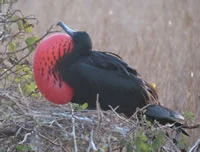Far off the coast of Ecuador, straddling the equator, lies an archipelago of storied islands-the Galapagos. In 1835 Charles Darwin visited the Galapagos during his historic voyage on the HMS Beagle. In 1859 Darwin published his theory of natural selection based on his observations in the Galapagos more than twenty years earlier. Since then, the Galapagos Islands have attracted naturalists, scientists, writers, and the just plain curious (also known as tourists), drawn to the archipelago by its unique, diverse species.
The Galapagos Islands (literally the Islands of the Tortoises) are especially attractive to birders visiting the archipelago partly for historical reasons, but especially to view the unique diversity of birds and other creatures produced by natural selection on isolated islands as reported by Charles Darwin over a century ago.
Recently, our own Shirley Johnson presented a program entitled Galapagos-the Enchanted Isles based on her own voyage to the Galapagos. In her presentation Shirley showed photographs of the plants, animals, scenery, and, naturally, birds that inhabit the Galapagos, accompanied by lively commentary. She and her husband Bob photographed many of the fabled Galapagos birds-albatrosses, boobies, frigatebirds, penguins, and, of course, the Galapagos finches made famous by Darwin's journals. She discussed the symbiotic relationship between certain birds, like ground finches and Galapagos tortoises. These birds remove ticks and other annoying ectoparasites from the tortoise's skin with the full cooperation of the reptile. Similarly, she described the close link between the habitat of the Galapagos and the birds that live there. The nesting and feeding habits of the Cactus Finch and the prickly pear cactus, Opuntia, provided but one example. Finally, Shirley demonstrated the diversity that exists from island to island that Darwin recorded so long ago. The four species of endemic mockingbirds served as a fascinating example. Unlike the finches, Darwin had the foresight to label each of the mockingbird species he collected according to its island of residence. Later, Darwin recognized that speciation of these mockers correlated with the fact that they were able to breed in isolation, allowing their unique characteristics to emerge.
Most of us will never visit the Galapagos Islands, except vicariously. This program reminded us of the singular importance of the Galapagos in the history of science, evolution, and conservation.
Magnificent Frigatebird photo by Bob Johnson.
